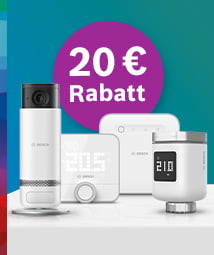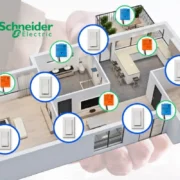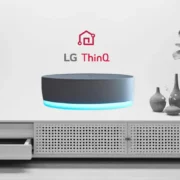Glossary

A
- Access Control: A system that restricts entry to a property or specific areas using key cards, biometrics, or codes.
- Actuator: A device that moves or controls a mechanism or system in response to a command signal.
- Air Quality Sensor: A device that measures the level of air pollutants in the home, such as CO2 or VOCs.
- Alarm System: A security system that detects and alerts residents to unauthorized entry or other emergencies.
- Alexa: Amazon’s cloud-based voice assistant used in Echo devices.
- Ambient Lighting: Lighting that provides general illumination to a space.
- Ambient Intelligence: An environment where devices interact seamlessly to improve quality of life.
- Android Auto: A mobile app developed by Google that mirrors features onto a car’s dashboard.
- Apple HomeKit: An Apple platform that allows users to control smart home devices using their iOS devices.
- Artificial Intelligence: The simulation of human intelligence in machines programmed to think and learn.
B
- Biometric Lock: A lock that uses fingerprint or facial recognition to grant access.
- BLE (Bluetooth Low Energy): A wireless technology designed for low power consumption, used in smart devices.
- Broadband: High-speed Internet access that is always on and faster than traditional dial-up.
- Bridge: A device that connects two networks, often used to make incompatible smart devices communicate.
- Building Management System (BMS): A system that controls and monitors a building’s electrical and mechanical equipment.
- Bulb Socket Adapter: A device that adds smart features to a traditional light bulb socket.
- Bus System: A network of devices that communicate via a common protocol, like KNX or DALI.
- Button Controller: A physical button that can control multiple smart home functions when pressed.
C
- Carbon Monoxide Detector: A device that detects the presence of carbon monoxide gas in the air.
- Central Hub: A main device that manages communication between smart home devices.
- Central Vacuum System: A built-in system that provides centralized vacuum cleaning throughout the home.
- Chime: An electronic sound device that alerts residents to doorbell rings or other signals.
- Climate Control: A system that controls temperature, humidity, and ventilation in the home.
- Closed Circuit Television (CCTV): A video surveillance system used for monitoring and security.
- Cloud Storage: A service that stores data on remote servers accessed via the Internet.
- Color Temperature: The measure of the color of light, ranging from warm to cool tones.
- Command: An instruction sent to a smart device to perform a specific action.
- Connected Car: A vehicle that can communicate with other devices or systems, often via the Internet.
- Connected Home: A residence where appliances and devices are interconnected via a network.
- Controller: A device that manages or controls other devices in a smart home system.
- Cortana: Microsoft’s voice assistant used in smart home devices and computers.
- CCTV Camera: A security camera connected to a CCTV system for surveillance purposes.
- Curtain Motor: A motorized device used to open or close curtains automatically.
D
- Daylight Harvesting: The practice of using natural light to reduce the need for artificial lighting.
- Deadbolt Lock: A type of lock that requires a key or code to unlock.
- Device Integration: The process of making different smart devices work together seamlessly.
- Digital Lock: A lock that requires a code, card, or biometric input instead of a traditional key.
- Dimmer Switch: A switch that allows the user to adjust the brightness of a light.
- Doorbell Camera: A smart camera integrated into a doorbell for monitoring visitors.
- Door Sensor: A device that detects when a door is opened or closed.
- Ductless HVAC: An HVAC system that operates without traditional ductwork, often using mini-split systems.
- Dusk-to-Dawn Sensor: A sensor that automatically turns lights on at dusk and off at dawn.
E
- Edge Computing: A processing method that handles data closer to where it is generated rather than sending it to a central server.
- Electrical Load: The amount of electrical power consumed by a device or system.
- Energy Management System (EMS): A system that monitors and controls energy consumption in a home.
- Energy Monitoring: The practice of tracking and analyzing energy usage in a home.
- Entry System: A system that controls access to a building, often with intercoms or card readers.
- Environmental Monitoring: Monitoring indoor environmental factors like temperature, humidity, and air quality.
- Ethernet: A wired networking technology used to connect devices in a local area network.
- Exhaust Fan: A fan that removes stale air from a room to improve ventilation.
F
- Facial Recognition: A biometric technology that identifies individuals by analyzing facial features.
- Fall Detection: A feature in some smart devices that can detect when a person has fallen.
- Fingerprint Scanner: A biometric device that identifies individuals based on fingerprint patterns.
- Firewall: A network security device that monitors and controls incoming and outgoing network traffic.
- Firmware: Software embedded in a device that provides control and functionality.
- Flood Sensor: A device that detects water leaks or flooding in the home.
- Floor Heating System: A heating system installed under the floor surface for radiant heating.
- Forced Air System: An HVAC system that distributes heated or cooled air through ductwork.
- Furnace: A device used to heat air and distribute it through a forced-air system.
G
- Gateway: A device that connects two networks, often used in smart home systems to connect to the Internet.
- Geofencing: A feature that triggers actions based on a device’s location within a virtual boundary.
- Gesture Control: A feature that allows control of devices through specific hand movements or gestures.
- Google Assistant: Google’s cloud-based voice assistant used in smart home devices.
- Green Building: A building designed to be environmentally friendly and resource-efficient.
- Grid-Tied System: A renewable energy system connected to the local power grid.
H
- Handheld Remote: A portable device that controls smart home systems and devices remotely.
- HDMI (High-Definition Multimedia Interface): A standard for transmitting high-definition video and audio signals.
- Home Automation: The automatic control of smart home devices and systems.
- Home Energy Management System (HEMS): A system that monitors and controls home energy use.
- Home Network: A network that connects devices within a home, typically via Wi-Fi or Ethernet.
- Home Security System: A system designed to protect a home from unauthorized access and emergencies.
- Home Server: A server installed in the home to manage files, media, and network devices.
- Home Theater System: An entertainment system that replicates the cinema experience at home.
- Hub: A central device that connects and controls multiple smart devices in a smart home network.
- Humidity Sensor: A device that measures the level of humidity in the air.
I
- IFTTT (If This Then That): A service that enables users to create custom automation rules for smart devices.
- Indoor Positioning System: A system that tracks the location of people or objects inside a building.
- Infrared (IR): A wireless communication technology using infrared light, often used in remote controls.
- Infrared Blaster: A device that emulates infrared signals to control traditional remote-controlled devices.
- Inverter: A device that converts DC power into AC power, often used in solar energy systems.
- IoT (Internet of Things): A network of interconnected devices that communicate over the Internet.
- IP Camera: A digital video camera that sends and receives data via the Internet.
- IP Intercom: An intercom system that uses Internet Protocol for communication.
- IR Remote: A remote control that uses infrared signals to communicate with devices.
J
- Junction Box: An enclosure for electrical connections to protect against electrical shocks and fire.
- Jalousie Window Motor: A motorized device used to open or close jalousie windows automatically.
K
- Key Fob: A small, handheld remote used to control smart home devices or unlock doors.
- Keyless Entry: Access to a property or vehicle without using a traditional key.
- Keypad Lock: A lock that requires a code entered on a keypad to grant access.
- KNX: An international standard for home and building automation.
L
- LAN (Local Area Network): A network that connects devices within a limited area, like a home.
- LED (Light-Emitting Diode): An energy-efficient lighting technology used in smart bulbs.
- Light Sensor: A device that measures the amount of light in a room.
- Lighting Automation: Automated control of lights based on time, occupancy, or other triggers.
- Load Shedding: The intentional reduction of electrical load to prevent overloading the power grid.
- Load Balancing: The distribution of electrical load across multiple circuits or devices.
- Location-Based Services: Services that provide data based on the geographical location of a device.
- Lock Cylinder: The part of a lock mechanism that turns to release the lock.
- Low-E Glass: Energy-efficient glass with a special coating to reduce heat loss or gain.
M
- Machine Learning: A type of AI that enables systems to learn and improve from experience.
- Mesh Network: A network topology where each node connects to multiple others, providing redundancy.
- Microcontroller: A compact integrated circuit designed to govern a specific operation in an embedded system.
- Motion Detector: A device that detects movement within its field of view.
- Multisensor: A device that combines multiple sensors, such as temperature, humidity, and motion.
- Multi-Room Audio: An audio system that allows music to be played in multiple rooms simultaneously.
- MyQ: A Chamberlain system that allows users to control garage doors remotely.
N
- Network Adapter: A device that connects a computer or smart device to a network.
- Nest: Google’s brand of smart home products, including thermostats and cameras.
- Noise Level Monitoring: Monitoring the level of ambient noise in a room or building.
- Non-Volatile Memory: Memory that retains data even when power is turned off.
- NVR (Network Video Recorder): A device that records video from IP cameras over a network.
O
- Occupancy Sensor: A sensor that detects whether a room is occupied and can control lighting or HVAC systems.
- Open Source: Software with source code that is freely available for modification and redistribution.
- Outdoor Camera: A security camera designed for outdoor use, typically weatherproof and durable.
- Over-The-Air (OTA) Update: Firmware or software updates delivered via the Internet directly to a device.
P
- Panic Button: A button that triggers an emergency alarm when pressed.
- Passive Infrared Sensor (PIR): A sensor that detects infrared light emitted by objects in its field of view.
- Patch Panel: A device that organizes and connects cables in a structured wiring system.
- Perimeter Security: Security measures designed to protect the outer boundary of a property.
- Personal Assistant: A voice-activated digital assistant like Siri or Google Assistant.
- Phishing: A cyber attack that tricks individuals into revealing personal information.
- Plenum Rated: Materials that meet fire safety standards for use in building air spaces.
- Plug-and-Play: Devices that work immediately when connected, without requiring complex setup.
- Powerline Adapter: A device that transmits network data over existing electrical wiring.
- Presence Detection: Detection of people in a room, often using sensors like PIR or ultrasonic.
- Proximity Sensor: A sensor that detects the presence of an object or person near the device.
- Programmable Thermostat: A thermostat that can be programmed to automatically adjust temperature settings.
Q
- Quantum Dot Display: A display technology that enhances color and brightness in LED screens.
- Quick Response (QR) Code: A two-dimensional barcode that can be scanned to access information or settings.
R
- Radiant Heating: Heating that uses infrared radiation to warm objects and people directly.
- Raspberry Pi: A small, affordable computer often used for DIY smart home projects.
- Reed Switch: An electrical switch operated by an applied magnetic field, used in door/window sensors.
- Relay Switch: An electrical switch that uses a low-voltage signal to control a high-voltage circuit.
- Remote Access: The ability to control a smart device from a distant location.
- Remote Control: A device used to control smart devices wirelessly, often via IR or RF signals.
- RFID (Radio Frequency Identification): A technology that uses electromagnetic fields to identify objects.
- Rocker Switch: A switch that rocks back and forth to open or close a circuit.
- Router: A network device that forwards data between computer networks, often used in Wi-Fi networks.
- Routine: A series of automated actions triggered by a specific event or schedule.
- Rule Engine: Software that enables users to define and enforce rules for smart home devices.
S
- Scene: A predefined setting that controls multiple smart devices simultaneously for a specific purpose.
- Security Camera: A camera used to monitor and record activity for security purposes.
- Security System: A system designed to detect and alert residents to security breaches or emergencies.
- Self-Monitoring: Monitoring a security system’s alerts without the help of a professional monitoring service.
- Sensor Fusion: The integration of data from multiple sensors to provide more accurate information.
- Server: A computer or system that provides data, resources, or services to other devices over a network.
- Shade Motor: A motorized device used to raise or lower window shades automatically.
- Siren: An alarm that produces a loud sound to alert residents of an emergency.
- Smart Appliance: A household appliance that can be controlled remotely and can communicate with other devices.
- Smart Bulb: An LED bulb that can be controlled remotely, often through an app or voice assistant.
- Smart Camera: A security camera with features like motion detection, two-way audio, and remote access.
- Smart Display: A smart speaker with a touchscreen display for showing information visually.
- Smart Doorbell: A doorbell with a camera and microphone that allows communication with visitors remotely.
- Smart Glass: Glass that can change its transparency or color when electrically activated.
- Smart Hub: A central device that connects and manages communication between smart devices.
- Smart Light Switch: A light switch that can be controlled remotely and programmed with schedules or scenes.
- Smart Lock: A lock that can be controlled remotely and may include features like biometric access.
- Smart Mirror: A mirror with an embedded display that can show information like weather or news.
- Smart Outlet: An electrical outlet that can be controlled remotely and may include energy monitoring features.
- Smart Plug: A plug-in device that adds smart features to traditional electrical devices.
- Smart Sensor: A sensor with additional features like remote access or integration with other devices.
- Smart Shades: Window shades that can be controlled remotely or programmed with schedules.
- Smart Speaker: A speaker with voice assistant capabilities, often used to control smart home devices.
- Smart Sprinkler System: A sprinkler system that can be controlled remotely and optimized for efficient water usage.
- Smart Switch: An electrical switch that can be controlled remotely and programmed with schedules or scenes.
- Smart Thermostat: A thermostat that can be controlled remotely and optimized for energy efficiency.
- Smart TV: A television with Internet connectivity and built-in apps for streaming and browsing.
- Smart Valve: A valve that can be controlled remotely to stop or start the flow of liquids or gas.
- Smart Water Leak Detector: A device that detects water leaks and alerts residents remotely.
- Smoke Detector: A device that detects smoke and alerts residents to potential fire hazards.
- Solar Panel: A device that converts sunlight into electricity, often used in renewable energy systems.
- Sound Sensor: A device that detects sound levels and can trigger automated actions.
- Speaker Zone: An area in a multi-room audio system where speakers are grouped together.
- Spring Return Motor: A motor that automatically returns to its original position after activation.
- Sprinkler Valve: A valve that controls the flow of water to a sprinkler system.
- Structured Wiring: A standardized cabling system used for data, audio, video, and control signals.
- Surveillance System: A network of cameras and devices used to monitor and record activity.
T
- Tablet: A portable touchscreen device often used to control smart home systems.
- Tamper Switch: A switch that detects and alerts when a device is being tampered with.
- Temperature Sensor: A device that measures temperature in a room or environment.
- Thermal Imaging Camera: A camera that detects heat patterns and visualizes them as an image.
- Thermostat: A device that controls the temperature in a home by regulating the HVAC system.
- Three-Way Switch: A pair of switches that control a single light or device from two different locations.
- Time-Based Automation: Automation that triggers actions based on a specific time or schedule.
- Touchscreen: A display that allows users to interact by touching the screen directly.
- Transceiver: A device that can both transmit and receive signals, often used in wireless communication.
- Two-Way Audio: An audio feature that allows both speaking and listening through a smart device.
U
- Ultrasonic Sensor: A sensor that measures distance using ultrasonic sound waves, often for presence detection.
- Underfloor Heating: A heating system installed under the floor surface for radiant heating.
- UPS (Uninterruptible Power Supply): A device that provides backup power in case of an electrical outage.
- Uplink: The transmission of data from a smart device to a central hub or server.
- USB Hub: A device that expands a single USB port into multiple ports.
- User Authentication: The process of verifying a user’s identity before granting access to devices or systems.
V
- Valve Actuator: A device that opens or closes a valve automatically in response to a command signal.
- Ventilation Control: A system that controls airflow to maintain indoor air quality.
- Video Doorbell: A doorbell with a built-in camera and microphone for remote monitoring and communication.
- Virtual Assistant: A software agent like Siri or Alexa that can perform tasks and provide information.
- Virtual Reality (VR): An immersive simulated experience using a head-mounted display and motion tracking.
- Voice Assistant: A software assistant that responds to voice commands, often used in smart speakers.
- Voice Control: The ability to control devices using voice commands.
W
- Wall Controller: A device mounted on a wall to control smart home devices.
- WAN (Wide Area Network): A network that connects devices over a large geographical area.
- Water Leak Detector: A device that detects water leaks and alerts residents to potential flooding.
- Water Shutoff Valve: A valve that automatically shuts off water flow in the event of a leak.
- Wearable Device: A smart device designed to be worn on the body, such as a smartwatch.
- Wi-Fi 6: The sixth generation of Wi-Fi technology, offering higher speeds and better connectivity.
- Wi-Fi Extender: A device that extends the range of a Wi-Fi network.
- Wi-Fi Mesh System: A network system that uses multiple access points to provide seamless Wi-Fi coverage.
- Window Sensor: A device that detects when a window is opened or closed.
- Wireless Charger: A device that charges smart devices without the need for physical cables.
- Wireless Protocol: A standard or set of rules for wireless communication between devices.
- Wired Network: A network that connects devices using physical cables, such as Ethernet.
X
- X10: An early home automation protocol that uses power lines for communication.
- Xiaomi Mi Home: Xiaomi’s smart home platform for controlling and automating devices.
Y
- Yale Smart Lock: A brand of smart locks that can be controlled remotely or via a keypad.
Z
- Z-Wave: A wireless protocol designed for smart home devices, offering low power consumption and secure communication.
- Zigbee: A wireless communication protocol for smart home devices, known for its mesh networking capabilities.
- Zone Heating/Cooling: A system that divides a home into zones, each with independent temperature control.
- Zone Valve: A valve that controls the flow of water or air to a specific heating or cooling zone.
- Zoning System: An HVAC system that divides the home into zones for independent climate control.
Random
AC Motor: An electric motor that operates on alternating current (AC).
Active Noise Cancellation: A technology that reduces unwanted noise using sound waves.
Air Duct Cleaning: The process of cleaning the air ducts in an HVAC system.
Analog Signal: A signal that varies continuously and is used in traditional home automation systems.
ANSI/BHMA: American National Standards Institute/Builders Hardware Manufacturers Association; they certify security products.
API (Application Programming Interface): A set of protocols for integrating software applications.
ASD (Adaptive Sound Damping): A feature that adjusts sound levels based on environmental noise.
Auto-Calibration: The automatic adjustment of a system to optimize performance.
Auxiliary Power Supply: A secondary power source used to ensure uninterrupted operation.
Bandwidth: The maximum rate of data transfer across a network or communication system.
Base Station: A central device that manages communication between sensors and other devices.
Battery Backup: A secondary power source that provides power during an electrical outage.
Battery Life: The amount of time a device can operate on a single battery charge.
Biometrics: The measurement and analysis of biological data, such as fingerprints or facial recognition.
Blind Motor: A motorized device used to open or close window blinds automatically.
BLE Beacons: Small Bluetooth devices that broadcast signals to nearby devices.
Building Envelope: The physical barrier between the interior and exterior environments of a building.
Centralized System: A system where all control and processing occur in a central hub or server.
Cloud Computing: The delivery of computing services over the Internet.
Code Compliance: Adherence to local building codes and standards.
Control Panel: A user interface that provides control over a system or device.
Data Encryption: The process of converting data into a secure format to prevent unauthorized access.
Deep Learning: A subset of machine learning that uses neural networks with many layers.
Device Management: The administration of devices within a smart home network.
Digital Signal: A signal that uses discrete values for transmission, common in smart home systems.
Digital Twin: A virtual representation of a physical device or system.
Door Strike: A plate or mechanism in a door frame that receives the latch or bolt of a lock.
Door Viewer: A peephole or camera that allows residents to see outside without opening the door.
Dual-Band Router: A router that operates on both 2.4 GHz and 5 GHz frequency bands.
Edge Gateway: A device that bridges IoT devices with the cloud, enabling edge computing.
Electric Meter: A device that measures and records electrical energy consumption.
Energy Harvesting: The process of capturing and storing energy from external sources.
Environmental Sensor: A sensor that measures environmental factors like temperature or humidity.
Ethernet Cable: A cable used to connect devices to a wired network.
False Alarm: An alarm triggered without an actual emergency, often due to sensor malfunction.
Fixed IP Address: An IP address that remains constant for a particular device.
Frequency Hopping: A technique that reduces interference by rapidly switching frequencies during transmission.
Gateway Router: A device that connects a local network to the Internet.
Grid Independence: The ability to operate independently from the power grid, often through renewable energy.
Ground Fault Circuit Interrupter (GFCI): A device that prevents electrical shock by detecting ground faults.
Guest Network: A separate Wi-Fi network for visitors that restricts access to the primary network.
Home Gateway: A device that provides access to broadband Internet for smart home devices.
Hybrid System: A system that combines multiple technologies, like solar panels and batteries.
Indoor Air Quality (IAQ): The quality of air inside buildings, influenced by pollutants and ventilation.
Input/Output (I/O): The communication between a computer and its external devices.
Integrated System: A system where multiple devices and subsystems work together seamlessly.
Interference: The disruption of communication signals due to overlapping frequencies or other factors.
IoT Gateway: A device that connects IoT devices to the cloud or local network.
Keyless System: An access system that doesn’t require traditional keys, often using codes or biometrics.
Latent Heat: The heat required for a substance to change state without changing temperature.
Lighting Schedule: A preprogrammed schedule for turning lights on and off automatically.
Load Controller: A device that manages the electrical load for efficient energy use.
Local Processing: Data processing that occurs on the device itself rather than a central server.
Long-Range Radio (LoRa): A wireless communication technology for long-range, low-power IoT applications.
Low-Power Wide-Area Network (LPWAN): A network designed for long-range, low-power IoT communication.
Machine-to-Machine (M2M): Direct communication between devices without human intervention.
Mobile App: An application designed for smartphones or tablets to control smart home devices.
Multi-Zone System: An HVAC system that allows for independent temperature control in multiple zones.
Occupant Detection: Detection of the presence of occupants in a building, often using sensors or cameras.
On-Demand Water Heater: A water heater that heats water only when needed, reducing energy consumption.
Overcurrent Protection: A safety feature that prevents excessive current in an electrical circuit.
P2P (Peer-to-Peer): A communication model where devices communicate directly without a central server.
Packet Loss: The failure of data packets to reach their destination over a network.
Parental Control: Features that restrict or monitor children’s access to content and devices.
Passive House: An energy-efficient building standard that minimizes energy consumption.
Permanent Magnet Motor: A motor that uses permanent magnets for improved efficiency.
PLC (Power Line Communication): Communication over existing power lines for data transmission.
Power Conditioning: The process of improving the quality of power delivered to electrical devices.
Predictive Maintenance: The use of data analytics to predict equipment failures before they occur.
Programmable Logic Controller (PLC): A digital computer used for automation of industrial processes.
Pulse-Width Modulation (PWM): A technique that controls the power delivered to electrical devices.
Redundancy: The duplication of components or functions to improve system reliability.
Ring Network: A network topology where each device is connected to two others, forming a ring.
Robotic Vacuum: An autonomous vacuum cleaner that navigates and cleans floors without human intervention.
Rolling Code: An encryption method that changes the access code with each use for improved security.
Secure Socket Layer (SSL): A protocol for securing communication over a network.
Sensor Calibration: The process of adjusting a sensor to improve its accuracy.
Smart Building: A building equipped with automated systems for energy efficiency and comfort.
Switching Power Supply: A power supply that regulates output voltage through high-frequency switching.
Thermistor: A type of resistor that changes resistance with temperature changes, used in temperature sensors.











